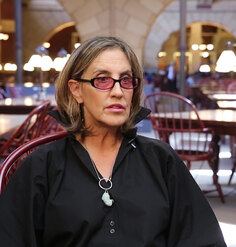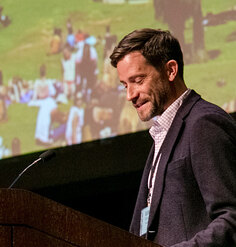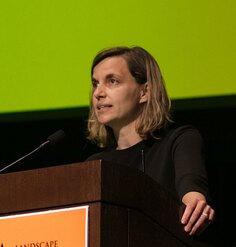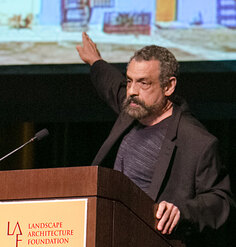Into an Era of Landscape Humanism
By Gina Ford
This presentation was part of the Landscape Architecture Foundation’s The New Landscape Declaration: A Summit on Landscape Architecture and the Future held in Philadelphia on June 10-11, 2016. LAF asked a diverse group of leading minds to write a “Declaration” reflecting on the last half century and offering bold ideas for how landscape architecture can make its vital contribution in response to the challenges of our time.
Gina Ford
Principal and Chair of Urban Studio, Sasaki Associates
Watertown, Massachusetts
Gina Ford is principal, landscape architect, and chair of Sasaki’s Urban Studio. She holds degrees in architecture from Wellesley College and landscape architecture from Harvard Graduate School of Design.
*Affiliation at the time of the Summit
Into an Era of Landscape Humanism
By Gina Ford
The landscape architect is uniquely rooted in the natural sciences. He is essential in maintaining the vital connection between man and nature.
—1966 Declaration of Concern
Fifty years ago, the voice of our profession was eerily prescient, undeniably smart, and powerfully inspired. It was also, let us admit it, almost entirely white and male.
I note this with no disrespect to the six incredible leaders of our profession who penned the 1966 Declaration of Concern. Their call to reconcile the needs of humankind with sound knowledge and respect for the natural processes of our environment is as relevant today as it was then or even more so. Equally, their edict for landscape architects to command the technical skillsets associated with natural resources and processes (geology, physiography, climatology, and ecology) remains of vital importance.
Yet, as we look forward and consider the significance of climate change, demographic shifts, and income inequality, the declaration’s “man” as nature’s antagonist feels strangely abstract and incomplete. To maintain relevance over the next 50 years, the profession needs to demonstrate the highest level of natural systems expertise but must devote equal attention to the human dimension of the equation. Accordingly, this response outlines some reasons why we as a profession need to diversify our ranks, as practitioners need to sharpen our technical skills vis-à-vis the needs of the people we serve, and as collaborators need to hone our communication skills and leadership prowess.
Our profession: diversify our ranks
The 1966 Declaration of Concern calls for recruiting and retaining more trained landscape professionals to help fight the environmental crisis. Yet broadening our social impact over the next 50 years will also require diversifying ranks and retaining population segments that have historically seen slim representation or significant attrition. Our national population demographic is changing dramatically, but our profession’s membership does not correlate with this trend. Between 2000 and 2010, the Hispanic and Latino population increased by 43 percent, and the African-American population by 12.3 percent, but together these groups represent less than 10 percent of the membership of the American Society of Landscape Architects (ASLA). Moreover, while many graduating classes from the country’s best schools of landscape architecture are predominantly female (and have been for a number of years), the percentage of women in leadership positions in private practice is still far from representative.
These imbalances are certainly not unique to landscape architecture, and more and more are seen across industries as both a socio-ethical challenge and a barrier to achieving more innovation. In general terms, the business case for diversity includes the cost savings associated with the retention of talent, the value of mirroring the profile of the marketplace, and the quality of ideas generated by less homogeneous teams. In design terms, our ability to stay relevant as a profession relies on our desire to reflect the broader population and embrace more diverse perspectives and approaches.
In practice: design with humanity
The 1966 Declaration of Concern points to a series of impending environmental disasters and laments the potential for “life in such polluted environments” to become “the national human experience.” I have personally worked in a number of communities affected by recent natural disasters, including floods in the Midwest, hurricanes on the Atlantic shore, and oil spills along the Gulf Coast. The hard fact is that many of our most socially vulnerable populations experience these heavily affected, polluted environments daily. More often than not, the communities most affected by natural disasters are those that are already unwittingly living with the highest levels of risk, the fewest resources for recovery, and the most underrepresented voices in broader planning dialogues.
From New York City to New Orleans, designers and planners who focus on resilience have come to realize that addressing significant environmental change demands tackling issues of social equity. We need landscape architects who understand social networks and cultural fabrics to both inspire participation in this critical dialogue and build governance toward lasting, meaningful, and sustainable change.
Collaboration: cultivate an ecosystem
The 1966 Declaration of Concern urges “a new collaborative effort to improve the American environment.” Truly sustainable development requires careful orchestration of complex layers of technical expertise as well as the inclusion of many distinct voices and constituencies. Now, more than ever, landscape architects are taking the lead on highly complex and multijurisdictional problems. Our unique ability to understand interconnected natural and human systems positions landscape architects as leaders among interdisciplinary teams and positions design as the key link among the planning, social science, and engineering disciplines. This undertaking requires exceptional communication skills from its leaders, who must translate these planning, science, and engineering concepts into legible and inspiring materials for shared evaluation and understanding.
From the reclamation of the Los Angeles River to the post-Sandy regional response led by Rebuild by Design, landscape architects are truly in the lead on some of the complex problems of our time. As we tackle these challenges, it is our softest skills—communication, leadership, empathic listening—that will enable successful engagement and positive design outcomes.
The future of our profession is bright. The world needs us now perhaps more than ever before. We must leverage this moment and bring the best of our nation’s talent to bear. If we embrace humanism as a core value in our profession, we truly can overcome the seemingly herculean challenges we face. It will certainly require understanding the specifics of the processes of our physical environment. We will also need to wholeheartedly embrace the rich diversity of who we are and strive more ambitiously to understand and meet the needs of the people we serve.











